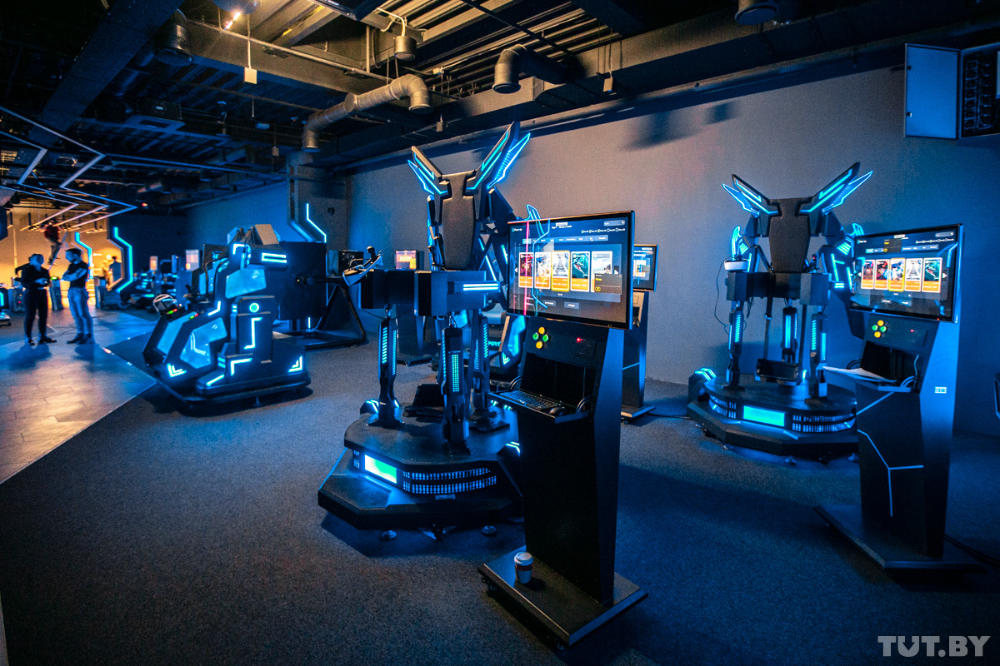From the golden age of classic arcades in the 1980s to today’s cutting-edge VR game machines, gaming has undergone a remarkable transformation. The former, with their simplicity and social appeal, remain timelessly popular. Meanwhile, virtual reality machines offer immersive, interactive experiences that push the boundaries of technology. Both eras continue to captivate players, showcasing the enduring appeal of gaming in its many forms. In this article, we will delve into the captivating history and ongoing allure of classic and contemporary gaming experiences.
Classic Arcade Games: Nostalgia and Timeless Fun
The allure of classic arcade games persists, transcending generations and technological advancements. These timeless treasures continue to captivate players worldwide, evoking a sense of nostalgia while offering uncompromised fun and excitement. To further know its features, let’s go reading.

Key Features of Classic Arcade Games
Classic arcade games boast a unique social dimension, fostering camaraderie and friendly competition as players gather around cabinets, vying for high scores. Their simple yet addictive gameplay mechanics make them accessible to players of all ages and skill levels, ensuring enduring popularity. Besides, the communal atmosphere of arcades created lasting memories and a sense of community, enhancing the overall gaming experience.
Popular Classic Arcade Games
Classic arcade games have left an indelible mark on nostalgic gaming culture. These beloved titles have stood the test of time, captivating players with their timeless charm and challenging gameplay. Here are some popular traditional arcade games:
- Pac-Man: Released in 1980, this iconic game features a yellow, pellet-eating character navigating a maze while avoiding ghosts. Its simple yet challenging gameplay has made it a timeless favorite.
- Space Invaders: A pioneer of the shooter genre, this 1978 game involves defending Earth from descending alien invaders. Its innovative mechanics and increasing difficulty captivated players worldwide.
- Donkey Kong: Introduced in 1981, this game marked the debut of Mario. Players must navigate platforms and ladders to rescue a damsel in distress from the giant ape, Donkey Kong.
- Galaga: This 1981 classic is a space shooter where players control a starfighter, battling waves of alien ships. Its addictive gameplay and iconic design have kept it popular for decades.
VR Simulator Machines: Thrill in Tech
The advent of VR technology has revolutionized the gaming landscape, offering unparalleled levels of immersion and interactivity. VR simulator machines provide players with an exhilarating escape into virtual worlds, pushing the boundaries of traditional gaming experiences.

Key Features of VR Simulator Machines
VR simulator machines excel in delivering unparalleled immersion, interactivity, and realism.
- The immersive vr experience is achieved through advanced graphics and 360-degree environments that fully engage the senses.
- Interactivity is enhanced with VR gaming technology, including motion tracking and responsive controls, allowing players to interact with the virtual world in intuitive ways.
- Realism is brought to life with high-definition visuals, spatial audio, and haptic feedback, creating a convincing and engaging virtual experience.
These features collectively make VR gaming an incredibly engaging and transformative experience, setting it apart from traditional gaming formats.
Popular VR Arcade Games for Sale
From heart-pounding adventures to mind-bending puzzles, the world of VR gaming offers a diverse array of experiences for players to explore. Here are the 7 best virtual reality machines that garnered critical acclaim for their innovative gameplay and immersive storytelling.
- VR Super Ride Simulator: This game offers thrilling roller coaster experiences with realistic motion and dynamic environments, making players feel as if they’re on an actual ride.
- VR Chair 360: Providing a full 360-degree rotational experience, this game immerses players in various virtual scenarios, from space battles to flight simulations.
- VR Motorcycle Simulator: Feel the rush of high-speed racing on different terrains with realistic motorcycle controls and stunning graphics.
- VR Horse Riding: Experience the joy of horseback riding through scenic landscapes with lifelike horse movements and interactive controls.
- VR Shark: Dive into the depths of the ocean and experience close encounters with sharks. This game combines educational content with thrilling underwater adventures.
- Superhot VR: A unique shooter where time moves only when you move, offering strategic combat and an immersive, slow-motion action experience.
- Half-Life: Alyx: Set in the Half-Life universe, this critically acclaimed game features intense gameplay, stunning visuals, and a deeply immersive narrative.
Classic Arcades vs. VR Game Machines: What’s the Difference
While both classic arcades and VR game machines offer unique gaming experiences, they differ in gameplay dynamics, accessibility, and types of engagement. Understanding these distinctions allows players to choose the gaming experience that best suits their preferences and interests.
Gameplay Differences: Simplicity vs. Complexity
Classic arcade games are known for their simple yet addictive gameplay mechanics, requiring quick reflexes to achieve high scores. In contrast, VR games often feature more complex gameplay elements, utilizing motion controls and spatial awareness to immerse players in virtual worlds.
For instance, Pac-Man involves navigating a maze and eating pellets while avoiding ghosts, a concept that is immediately understandable. Space Invaders requires moving a shooter left and right to hit descending aliens. These straightforward mechanics are easy to grasp, making the games accessible and enjoyable from the first play.
In contrast, VR game machines like Half-Life: Alyx offer complex gameplay with detailed storylines, intricate puzzles, and a high level of interactivity. Players must navigate 3D environments, solve puzzles, and manage resources, providing a deep and engaging experience that requires more time to master.
Accessibility and Learning Curves
Classic arcade games boast minimal learning curves, with intuitive controls that anyone can pick up and play. On the other hand, VR games may have steeper learning curves, requiring players to acclimate to new control schemes and navigate virtual environments with precision and finesse.
Games like Donkey Kong only require players to move and jump, making them accessible to people of all ages and skill levels. Their intuitive controls and straightforward objectives enable quick and easy engagement.
On the other hand, VR game machines like Superhot VR require players to learn new hardware and controls, such as hand tracking and spatial movement. This learning curve can be steeper, as players need to adapt to VR technology. However, once players become accustomed to these controls, they can fully enjoy the immersive and interactive nature of VR games, making the initial effort worthwhile.
Different Types of Engagement: Short Bursts vs. Long Sessions
Classic arcade games are designed for short, intense bursts of gameplay, making them perfect for quick gaming sessions during breaks or downtime. In contrast, VR games often encourage longer play sessions, as players become fully immersed in the virtual worlds they inhabit, losing track of time in the process.
For example, a game of Galaga can last just a few minutes, providing instant fun and immediate replayability. This quick, repetitive gameplay is ideal for social settings, where players can take turns and compete for high scores.
In contrast, VR games like VR Motorcycle Simulator and VR Chair 360 are often built for longer sessions around 5 minutes, offering immersive experiences that encourage extended play. For some multiplayer VR games, players can even spend hours exploring virtual worlds or completing detailed missions, providing a more in-depth and sustained engagement compared to the quick bursts of arcade gaming.
The Best of Hybrid Arcades: Combining Classic and VR
As gaming continues to evolve, modern arcades are embracing the synergy between classic and VR gaming experiences. Hybrid arcades that offer a diverse selection of both classic arcade games and cutting-edge VR experiences are gaining popularity, catering to a wide range of players with varying preferences.
How Are Modern Arcades Integrating VR Experiences?

Modern arcades are embracing VR technology to enhance the gaming experience. Many arcades now feature dedicated VR zones or sections where players can immerse themselves in virtual worlds. These areas are equipped with high-quality VR headsets, motion-tracking systems, and interactive peripherals like controllers or hand trackers. Some arcades even offer full-body motion platforms that synchronize with VR experiences, providing a more realistic and engaging sensation.
Additionally, arcade operators often curate a selection of popular VR games and experiences, ensuring there’s something for every player. This integration of VR into traditional arcades adds a new dimension to gaming, attracting both newcomers and enthusiasts alike.
The Future of Gaming
The arcade gaming history has told the future of gaming. With technological advancements, VR and AR are set to revolutionize the gaming landscape, offering immersive experiences that blur the lines between reality and virtual worlds. Furthermore, the rise of cloud gaming services and subscription-based models is democratizing access to a vast library of games across multiple platforms. Here are some real data about the VR game market:
- VR and AR: According to Statista, the global VR gaming market was valued at $15.78 billion in 2020 and is projected to reach $53.6 billion by 2027. The rise of VR headsets like Oculus Rift and PlayStation VR indicates a growing interest in immersive gaming experiences.
- Cloud Gaming: Data from Newzoo suggests that the cloud gaming market will generate $4.8 billion in revenue by the end of 2023. Services like Google Stadia, Microsoft’s Xbox Cloud Gaming (formerly Project xCloud), and NVIDIA GeForce Now offer users the ability to stream games instantly across devices, marking a shift towards accessibility and convenience.
Despite these innovations, the enduring appeal of retro gaming aesthetics continues to influence modern game design, ensuring that nostalgia remains a driving force in the future of gaming.
- Classic Arcade and Retro Gaming Trends: The popularity of retro gaming is evident in the success of products like the Nintendo Classic Mini series and the SEGA Genesis Mini. Moreover, data from The NPD Group shows that sales of retro gaming hardware, software, and accessories in the United States increased by 26% in 2020 compared to the previous year.
These facts highlight the diverse influences shaping the future of gaming, from cutting-edge VR technology to the enduring appeal of classic and retro gaming experiences.
Conclusion
Gaming has come a long way since the days of classic arcades, evolving into a multi-billion dollar industry that spans the globe. Whether you’re a fan of retro classics or cutting-edge VR experiences, there’s never been a better time to explore the diverse world of gaming. So why not set up the latest arcade with some VR game machines or equip it with a VR headset and embark on your VR gaming business today?
FAQs
What Made Classic Arcades So Popular?
Classic arcades were popular because they offered a unique, social gaming experience that couldn’t be replicated at home. The combination of cutting-edge technology, competitive gameplay, and a communal atmosphere made them a cultural phenomenon.
How Has VR Changed the Gaming Landscape?
VR has revolutionized the gaming landscape by offering immersive experiences that transport players into virtual worlds like never before. It has opened up new possibilities for gameplay, interaction, and socialization, fundamentally changing how we perceive and engage with games.
Are Arcades Making a Comeback?
While traditional arcades have declined in popularity, there has been a resurgence of interest in retro gaming and arcade culture. Retro arcades and barcades are popping up in cities around the world, attracting both nostalgic gamers and a new generation eager to experience classic games in their original form.
What’s Needed to Set Up a VR Gaming Station?
Setting up a VR gaming station requires a VR headset, compatible controllers, and a powerful gaming PC or gaming console. Additionally, you’ll need enough space to move around comfortably, as many VR experiences involve physical movement.
How Do Classic Arcades and VR Games Differ in Terms of Social Interaction?
Classic arcades fostered social interaction through physical gatherings and face-to-face competition. In contrast, VR games offer social interaction in virtual spaces, allowing players to connect with others from around the world through avatars and voice chat. While both forms of gaming encourage socialization, they do so in different ways, reflecting the technological advancements and cultural shifts of their respective eras.



